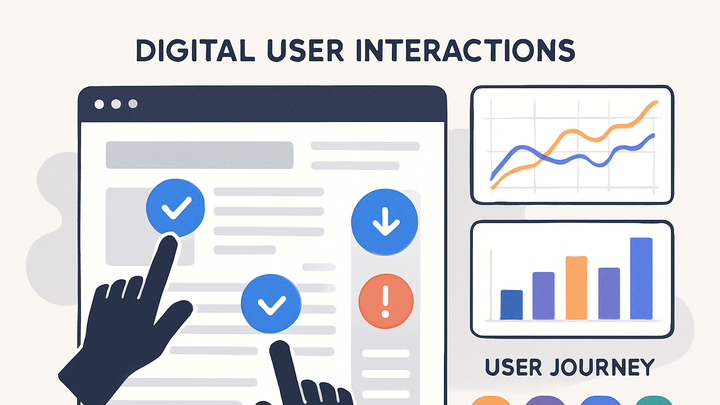Published on 2025-06-26T04:25:51Z
What is Behavioral Analytics? Examples and Applications.
Behavioral analytics is the practice of analyzing user interactions with websites, apps, and digital products to understand patterns, motivations, and pain points. By capturing events such as clicks, page views, and form submissions, data teams can reconstruct user journeys and identify key drop-off points. Tools like GA4 or PlainSignal enable businesses to track these interactions with event-based data collection and minimal reliance on cookies. Through behavioral analytics, organizations gain actionable insights to personalize marketing campaigns, optimize user experiences, and drive higher engagement and conversions. This approach differs from aggregate metrics by focusing on individual or cohort behavior rather than overall traffic counts. Privacy-friendly solutions like PlainSignal’s cookie-free tracking ensure compliance with data protection regulations without sacrificing data quality. As companies strive for customer-centric strategies, behavioral analytics has become indispensable for informed decision-making and continuous product improvement.
Behavioral analytics
Behavioral analytics examines user actions on digital platforms to uncover patterns, optimize experiences, and boost conversions.
Importance of Behavioral Analytics
Behavioral analytics provides deep insights into how and why users interact with your digital products. By understanding the events that lead users from discovery to conversion, teams can make data-driven decisions to enhance performance and customer satisfaction. This section explores the key benefits organizations gain from adopting behavioral analytics.
-
Enhanced user understanding
Tracks individual and cohort behaviors to reveal motivations, preferences, and pain points, enabling more empathetic and effective product design.
-
Personalization at scale
Leverages insights from user actions to deliver tailored content, recommendations, and experiences that resonate with specific audience segments.
-
Conversion rate optimization
Identifies friction points in the user journey and tests targeted changes to increase sign-ups, purchases, and other key conversion metrics.
-
Product improvement
Informs feature development and roadmap priorities by highlighting which features drive engagement and which are underused.
Key Components of Behavioral Analytics
Successful behavioral analytics relies on several core components, including event tracking, analytics frameworks, and data analysis techniques. Together, these elements allow teams to collect, process, and interpret user interaction data effectively.
-
Event tracking
Captures discrete user actions (e.g., clicks, form submissions, page views) as events that can be analyzed and aggregated for insights.
-
User journey mapping
Visualizes the sequence of events a user follows across sessions and touchpoints, revealing common paths and drop-off locations.
-
Funnel analysis
Defines and tracks the conversion funnels—series of steps users must complete to achieve a goal—to pinpoint stages with high abandonment rates.
-
Cohort analysis
Groups users based on shared characteristics or behaviors over time to compare retention, engagement, and conversion across cohorts.
Implementing Behavioral Analytics
Implementing behavioral analytics involves selecting the right tools, deploying tracking mechanisms, and maintaining data privacy. This section outlines a step-by-step approach using popular SaaS platforms like GA4 and PlainSignal.
-
Choosing the right tool
Evaluate platforms based on event tracking capabilities, privacy features, ease of setup, and integration with your tech stack. For example, GA4 offers deep integration with Google’s ecosystem, while PlainSignal provides cookie-free tracking for privacy-centric use cases.
-
Deploying tracking code
Insert the provider’s snippet into your site to start capturing events. For PlainSignal, the minimal, cookie-free snippet looks like:
<link rel="preconnect" href="//eu.plainsignal.com/" crossorigin /> <script defer data-do="yourwebsitedomain.com" data-id="0GQV1xmtzQQ" data-api="//eu.plainsignal.com" src="//cdn.plainsignal.com/plainsignal-min.js"></script> -
Defining events and properties
Plan and document the events you need (e.g.,
purchase_completed,signup_started) along with relevant properties (e.g., product ID, user role) to ensure consistent data collection. -
Ensuring privacy compliance
Implement consent management and use privacy-first tools (like PlainSignal) to respect user preferences and comply with regulations such as GDPR and CCPA.
Use Cases and Examples
Behavioral analytics can be applied across industries to address diverse challenges. Here are some common scenarios where user behavior data drives measurable improvements.
-
E-commerce abandoned cart recovery
Analyzes drop-off points in the checkout funnel to trigger targeted email reminders or on-site messages, reclaiming lost sales.
-
Saas user onboarding
Monitors key onboarding steps, identifies where new users struggle, and provides in-app guidance or tutorials to boost activation rates.
-
Content engagement analysis
Tracks scrolling depth, video plays, and time on page to optimize content formats, headlines, and layout for better engagement.
